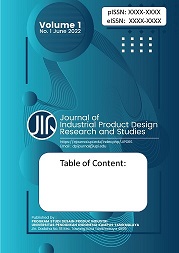The Design and Development of a Prayer Counter
Abstract
Keywords
Full Text:
PDFReferences
Azizah, N., Sujana, N., and Ajibroto, K. (2022). Implementasi Sensor Ultrasonik untuk Menghitung Rakaat Shalat Berbasis Arduino Uno. Formosa Journal of Multidisciplinary Research, 1(2), 187-196.
Akoy, E. A. O. M., Ismail, M. A., Ahmed, E. F. A., and Luecke, W. (2006). Design and construction of a solar dryer for mango slices. Proceedings of International Research on Food Security, Natural Resource Management and Rural Development-Tropentag. University of Bonn, Bonn, Germany.
Beitz, W., Pahl, G., and Grote, K. (1996). Engineering design: a systematic approach. Mrs Bulletin, 71.
Kasman, K., and Moshnyaga, V. G. (2017). New technique for posture identification in smart prayer mat. Electronics, 6(3), 61.
Sudin, M. N., and Ahmed, S. (2009). Investigation of change in specifications during a product's lifecycle. In DS 58-8: Proceedings of ICED 09, the 17th International Conference on Engineering Design, Vol. 8, Design Information and Knowledge, Palo Alto, CA, USA, 24.-27.08. 2009 (pp. 371-380).
Malek, M. K. A. A., Zakaria, N., Rubani, S. N. K., Hamzah, N., and Ariffin, A. (2021). Development of ‘Sejadah Pintar’using Design Thinking Process Model. Research and Innovation in Technical and Vocational Education and Training, 1(2), 018-027.
Nataliana, D., Fauziah, D., and Dianti, M. R. (2022). Development of Prayer Raka’at Counter Using Piezoelectric Sensor. REKA ELKOMIKA: Jurnal Pengabdian kepada Masyarakat, 3(2), 134-141.
Ahmed, S., and Wallace, K. (2003). Indexing design knowledge based upon descriptions of design processes. In DS 31: Proceedings of ICED 03, the 14th International Conference on Engineering Design, Stockholm.
Pugh, S. (1991). Total design: integrated methods for successful product engineering. Addison-Wesley.
Hubka, V., and Eder, W. E. (2012). Theory of technical systems: a total concept theory for engineering design. Springer Science & Business Media.
DOI: https://doi.org/10.17509/jipdrs.v2i1.55563
Refbacks
- There are currently no refbacks.
Copyright (c) 2023 Universitas Pendidikan Indonesia (UPI)

This work is licensed under a Creative Commons Attribution-ShareAlike 4.0 International License.

This work is licensed under a Creative Commons Attribution-ShareAlike 4.0 International License.



